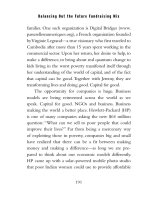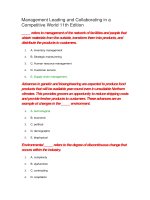Lecture Management: Leading and collaborating in a competitive world - Chapter 10: Human resource management
Bạn đang xem bản rút gọn của tài liệu. Xem và tải ngay bản đầy đủ của tài liệu tại đây (1.01 MB, 15 trang )
Human
Resource
Managemen
t
Chapter Ten
Copyright © 2015 McGrawHill Education. All rights reserved. No reproduction or distribution without the prior written consent of McGrawHill Education.
Learning Objectives
LO 1 Discuss how companies use human
resources management to gain competitive
advantage.
LO 2 Give reasons companies recruit both
internally and externally for new hires.
LO 3 Identify various methods for selecting new
employees.
LO 4 Evaluate the importance of spending on
training and development.
10-2
Learning Objectives (cont.)
LO 5 Explain alternatives for who appraises an
employee’s performance.
LO 6 Describe the fundamental aspects of a
reward system.
LO 7 Summarize how unions and labor laws
influence human resources management.
10-3
Human Resource Management
Human
resources
management
(HRM)
–
Formal systems for
the management of
people within an
organization.
10-4
Strategic Human Resources
Management
Human capital
–
The knowledge,
skills, and abilities
of employees that
have economic
value.
10-5
Figure 10.1
An Overview of the HR
Planning Process
10-6
The HR Planning Process
Job analysis
–
A tool for
determining what is
done on a given job
and what should be
done on that job.
10-7
Advice on Termination
Table 10.1
10-8
Training and Development
Training
–
Teaching lowerlevel employees
how to perform
their present jobs.
Development
–
Helping managers
and professional
employees learn
the broad skills
needed for their
present and future
jobs.
10-9
Training and Development
Needs
assessment
–
An analysis
identifying the jobs,
people, and
departments for
which training is
necessary.
10-10
Types of Training
Orientation training
–
Training designed to introduce new
employees to the company and familiarize
them with policies, procedures, culture, and
the like
Team training
–
Training that provides employees with the
skills and perspectives they need to
collaborate with others.
10-11
Performance Appraisal
Management by objectives (MBO)
–
A process in which objectives set by a
subordinate and a supervisor must be
reached within a given time period.
10-12
Performance Appraisal
360-degree appraisal
–
Process of using multiple sources of appraisal
to gain a comprehensive perspective on one’s
performance
10-13
Factors Affecting the Wage Mix
Figure 10.6
10-14
Determinants of Union
Voting Behavior
Figure 10.8
10-15









